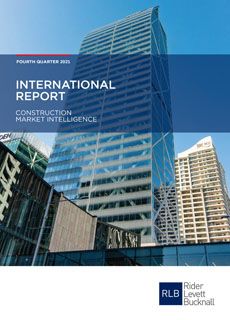According to Rider Levett Bucknall’s (RLB) 4th Quarter 2021 International Report, New Zealand has navigated the COVID-19 pandemic well, despite the recent outbreak and lockdowns (primarily within the Auckland region).
Mr Steve Gracey, Managing Director of RLB New Zealand said, “The long-term outlook remains positive. The fiscal and monetary policy of the central government has underpinned strong domestic demand and construction activity, particularly in residential construction where activity levels are at an all-time high.”
“The upsurge in construction activity and demand, in parallel with significant supply chain issues and closed borders, has seen severe capacity issues causing cost pressure, longer lead times and market uncertainty,” he said.
Supply issues expected to continue into 2022
Labour and material shortages are common across the entire country and while there is optimism that when the borders open (possibly early 2022) labour shortages may ease, the ongoing international supply issues and port congestion is expected to continue well into 2022.
The construction market sectors with the strongest growth are within horizontal infrastructure, industrial and data centres, health, and the retirement home development. Other sectors such as retail, hospitality and tourism have been majorly impacted by the pandemic and will take some time to recover.
Inflationary levels over the last quarter are at levels not seen since 1987, with construction being a major contributor to this. As a result, interest rates have been lifted modestly and further hikes are likely, which may dampen domestic demand.
General cost inflation, as measured by the Consumer Price Index, rose 2.2% in the September 2021 quarter, the highest quarterly rise since 1987. On an annual basis, the CPI rose 4.9% compared to construction escalation over the same period estimated at 7.3%. The forecast rise of construction costs is at levels not seen since 2004. Construction activity is at record levels.
Material supply issues and labour shortages driving a volatile market
Mr Gracey continued, ”There are severe material supply issues due to commodity prices, shipping costs, and delays in manufacture. Finally, there are significant labour shortages without a relief valve available to import the required labour.”
“All these factors are driving a very volatile market and increased costs. On larger projects with longer construction programmes, contractors are sometimes unwilling to provide fixed pricing on the material components of their bid. It is now common to see “fluctuating” clauses inserted into construction contracts that have not been seen since the 1980s and early 1990s,” he added.
“Clients are now encouraging early orders and procurement to mitigate further cost increases and ensure on time supply. We expect these issues will continue over the next few months, with cost escalation peaking around the end of the first quarter of next year.”
Development work expected to slow
Given the level of increased cost, the difficulty of securing resources and the nervousness of lending institutions, we expect development work to slow. However, with the significant pipeline of public work, RLB expects capacity issues to continue and an annual national escalation rate of between 5% and 6% in the 2022 calendar year.
As a summary, RLB is forecasting the following construction cost growth:
In 2022, of 5.5% for Auckland, 5.5% for Christchurch and 4.0% for Wellington.
In 2023, of 3.5% for Auckland, 3.0% for Christchurch and 3.0% for Wellington.
FURTHER INFORMATION:



